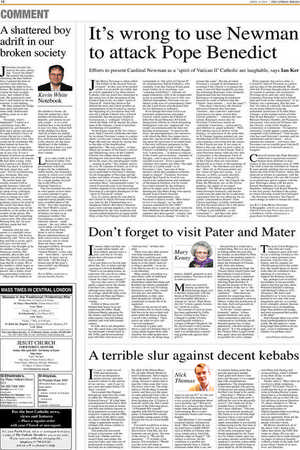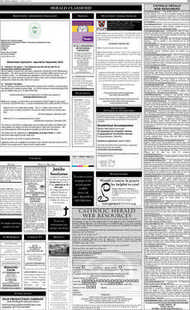Page 12, 16th April 2010
Page 12

Report an error
Noticed an error on this page?If you've noticed an error in this article please click here to report it.
Tags
Share
Related articles
Newman Can Lead Us Out Of Our Post-vatican Ii Turmoil
What Would Newman Make Of The Church Today?
‘hitler’s Pope’ Author Criticises Pope’s View Of Newman
Father Of The Post Conciliar Church
Doctor Newman And The Communion Of Saints
Nichols Presses Newman's Cause
It’s wrong to use Newman to attack Pope Benedict
Efforts to present Cardinal Newman as a ‘spirit of Vatican II’ Catholic are laughable, says Ian Ker John Henry Newman is often called “the Father of the Second Vatican Council”. In this year of his beatification it is no doubt inevitable that he will he appealed to by those liberal Catholic who are much less interested in the actual text of the documents of the Council than in the so-called “spirit of Vatican II” which they believe lies behind the texts and which justifies an interpretation of the Council as merely the beginning of a revolution that will turn the Catholic Church into a Church remarkably like the present Anglican Communion, a “collegial” Church in which the Pope will be merely the chairman of the bishops, a kind of glorified Archbishop of Canterbury.
In the Easter issue of the New Statesman, John Cornwell celebrates the feast by invoking Newman’s name in a particularly vicious and virulent attack on the Pope. He ends his article by saying that as the date of the beatification approaches: “We may expect... to hear tidied-up versions of Newman’s critical and liberalising views of the Catholic Church, but unlike those dissident theologians who have been suppressed down the years, his unexpurgated works ... remain in print.” Yes, indeed, and so do over 30 volumes of letters, as well as other volumes of writings that were never published in Newman’s lifetime. As the biographer of Newman and the author and editor of more than 20 books on Newman, I can claim to have consulted these “unexpurgated works” to which Cornwell (who is no Newman scholar) appeals in his attempt to present Newman as a dissident theologian of the “spirit of Vatican II” school.
It is, of course, perfectly true that in the Church in which Newman lived he was seen by the Ultramontanes as a dangerous liberal. But these Ultramontanes were extreme papalists, who were disappointed by the very moderate and circumscribed definition of papal infallibility at the First Vatican Council; their counterpart to “the spirit of Vatican II” of contemporary liberal Catholics, who similarly wish that Vatican II had gone much further in its teachings, was “creeping infallibility”, whereby all papal statements were to be exaggerated as far as possible. But even in that very illiberal atmosphere, Newman was no liberal in the eyes of contemporary liberals like Lord Acton who despised him for his deference to authority.
Even though Newman lived in an extremely authoritarian and papal Church, which makes the Church of John Paul II and Benedict XVI look dangerously liberal, in which dissenting theologians were not “suppressed” but simply excommunicated, he does not hesitate to pronounce: “I conceive the force, the peremptoriness, the sternness, with which the Holy See comes down upon the vagrant or the robber, trespassing upon the enclosure of revealed truth, is the only sufficient antagonist to the power and subtlety of the world...” The Church’s infallibility, Newman thought, was “a provision ... to preserve religion in the world, and to restrain... freedom of thought... and to rescue it from its own suicidal excesses”. Even a genuine reformer who speaks out when “the right time for it is [not] come” is, in Newman’s view, “just one of those persons whom the competent authority ought to silence”. Certainly, Newman thought the Church he lived in was excessively authoritarian and intolerant of theological freedom, but he would have been amazed by the tolerance shown by popes since Vatican II of theologians like Hans Küng who openly dissent from Church doctrine.
Cornwell appropriately cites Newman’s famous words: “Here below to live is to change”, as “an ideal mission statement for the 1960s”. Indeed, they would be very apt words for that rebellious decade had the previous sentence also been quoted – namely, that Christianity has to change “in order to remain the same”. Having invoked Newman’s concept of development as essential if the Church is to remain the same, Cornwell then laughably accuses the reforming Ratzinger (who allegedly degenerated into the reactionary Ratzinger) of opposing development because he came to believe that the Church “must remain ... ever the same”!
Then there’s the hoary old chestnut beloved of liberals that Newman “insisted... that a person’s individual conscience was more crucial than Church authority” – whereas the reactionary Ratzinger insists that for Newman “Conscience meant an ‘informed’ conscience... instructed by, and obedient to, papal authority”. Well, all Catholics have to believe in the primacy of conscience in the sense that, as St Thomas Aquinas pointed out, our membership of the Church rests on the conscientious conviction that the claims of the Church are true. If we cease to believe they are, then we have a duty in conscience to leave the Church. That is what Newman means when he says that “conscience is the aboriginal Vicar of Christ”. But if we believe in the claims of the Church, then our conscience should tell us to listen to the teachings of the Church – “he who hears you hears me”. After all, as Newman points out, our “sense of right and wrong... is so delicate, so fitful, so easily puzzled, obscured, perverted... so biassed by pride and passion” that “the Church, the Pope, the Hierarchy are, in the Divine purpose, the supply of an urgent demand”. The liberal assumption that, when Newman famously said that he would toast the pope but he would toast conscience first, he was allowing for socalled “conscientious dissent” from Church teachings, is totally unfounded. All that Newman allows for is the possibility of disobeying a papal order (“a Pope is not infallible... in his commands”) – and then only after “serious thought [and] prayer”. More original, but no less false, is Cornwell’s idea of Newman as a priest and his idea of the priesthood. We are told that Newman thought priests should be trained in parishes not seminaries; Newman never said any such thing. Certainly, Newman believed in friendship and lived in the “domesticity” of an Oratory not a monastery. But the idea that “his idea of a priestly lifestyle could not be more different from the outlandish asceticism of St John Mary Vianney, or the exalted notion of John Paul II and Benedict” is utterly bizarre. Blessed Dominic Barberi, the Passionist missionary who received Newman into the Church, wrote of his Anglican community at Littlemore: “A Capuchin monastery would appear a great palace compared with Littlemore.” And anyone who has read Newman’s journals and his meditations and devotions – not to mention his sermons – will know that Newman was no worldly post-Vatican II kind of priest, as Cornwell seems to imagine.
Cornwell claims that Pope Benedict underwent a mysterious transformation from reformer to reactionary in the revolutionary year of 1968. The truth is that the reformers at Vatican II were already splitting into two groups before the end of the Council: those who believed in reform in continuity with the Tradition and those who saw the Council as revolutionary and in rupture with the past. Ratzinger, along with the great French theologians, de Lubac and Daniélou, belonged with Karol Wojtyła, to the first group. And that is the group to which Newman would have belonged – the Newman who knew the Church must change in order to remain the same.
Ian Ker’s John Henry Newman: A Biography, which was reissued by Oxford University Press last year as a hardback, will be reissued as a paperback in September
blog comments powered by Disqus





















